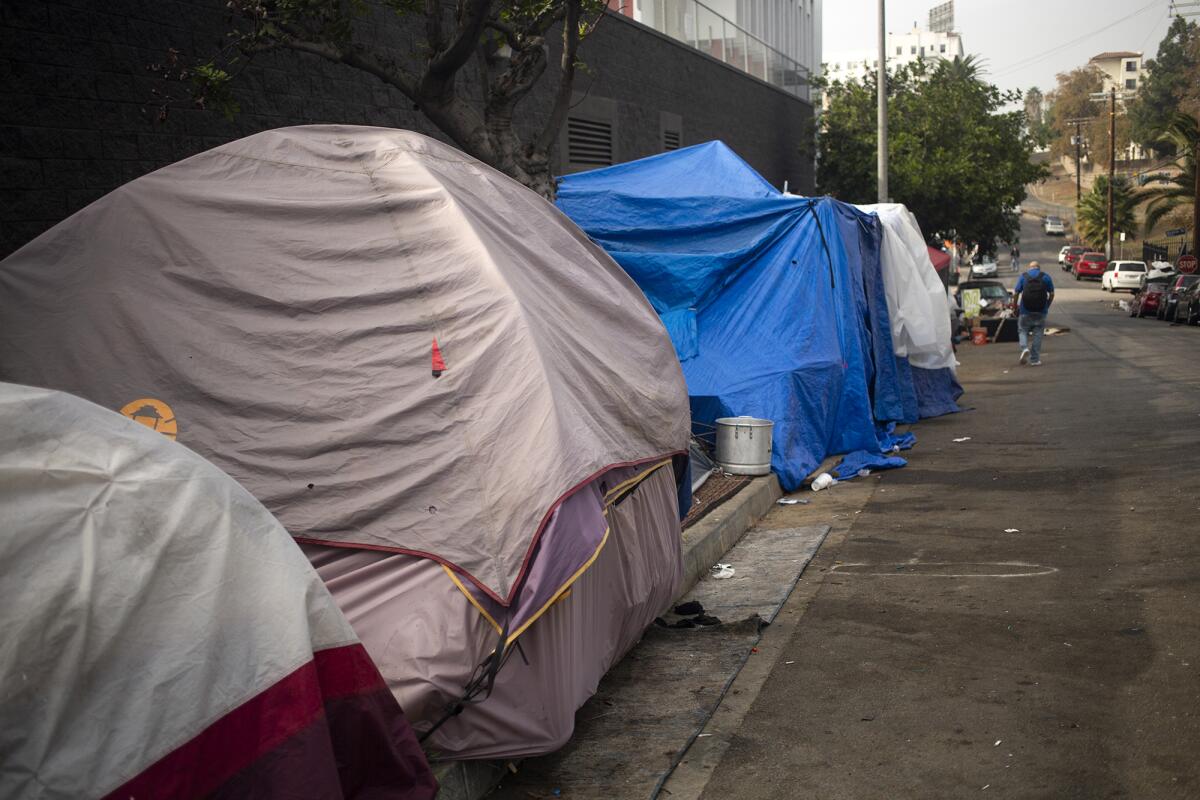Homeless deaths in L.A. dropped, but many are dying from drugs
Dakota Smith Lorena Iiguez Elebee March 29, 2024
Fewer homeless people died in Los Angeles in 2023 than
in
the previous year, with nearly two-thirds of the deaths linked to drugs.
The 23% drop in homeless deaths came even as the number of unhoused people has continued to climb in L.A. in recent years.
According to data released Thursday by City Controller Kenneth Mejia, 898 unhoused people died last year on streets, in shelters, on freeways and elsewhere.
Mejias report, which analyzed Los Angeles County Dept. of Medical Examiner data, did not break down the number of deaths linked to drugs because toxicology reports may be pending in some cases.
A Times analysis of the data found that about 65%, or 545, of the homeless deaths last year were linked to drugs, including fentanyl and methamphetamine an indication of the deadly toll of the drug crisis on the streets of L.A. The number could increase as more toxicology reports come in.
Sergio Perez, Chief of Accountability & Oversight in the Controllers Office, said the data shows that more services are needed.
It doesn’t matter if those deaths go up and down [each year], Perez said, What matters is that they are taking place. When an individual dies on the street, they don’t care if they’re part of a trend, where the deaths are decreasing or not.
Mayor Karen Bass, who has made reducing homelessness in Los Angeles her top priority, highlighted the decrease in deaths in a statement Thursday but said “there is still much more to be done.
Los Angeles is home to about 46,260 unhoused people an 80% increase since 2015, according to figures released last year by the Los Angeles Homeless Services Authority.
In recent years, the city has spent billions of dollars to address homelessness and build more housing. The fentanyl and meth
amphetamine
crisis has prompted city officials to fund treatment beds for homeless people suffering from addiction a service that has typically been paid for by county government, not City Hall.
According to Mejia’s report, 75% of the homeless deaths last year were accidental a category that includes drug-related deaths.
About 18% were due to natural causes, 4% were homicides and 2% suicides, the report said. In 1% of the deaths, the cause was undetermined.
At least 73% of the deaths occurred in streets or places such as tents, RVs and parking lots.
According to the report, 31% of the homeless people who died in 2023 were Black. Black people are 8% of the citys population but 33% of the unhoused population.
The report found that the parts of the city with the highest numbers of homeless deaths Council District 14, which includes Skid Row and Council District 1, which includes MacArthur Park near downtown.
Councilmember Kevin de Len called it
“
positive
“
that deaths had dropped but said it was an “indelible mark of shame” that nearly 900 unhoused people died last year. His district includes Skid Row.
Councilmember Eunisses Hernandez, who represents District 1, said the majority of homeless deaths in her district last year were due to opioids. She said she wants to bring more services to MacArthur Park, where many of those deaths occurred.
We cannot look away from this crisis the consequences of simply shuffling people from one neighborhood to the next and prioritizing criminalization over the delivery of services are at best ineffective, and at worst, deadly,” said Hernandez.
A report last year by the L.A. County Department of Public Health said that in 2022, fentanyl was the cause of almost 60% of accidental drug or alcohol overdoses in the overall county population. Fentanyl has surpassed meth
amphetamine
as the most common drug contributing to overdose deaths.
Jason Ward, an economist at the Santa Monica-based Rand Corp., a nonprofit research institute, said in an interview in February that he continues to see a very high rate” of mortality among unhoused people in Los Angeles because of fentanyl.
The fentanyl-related deaths are cutting so deep that the overall homeless population in the city is likely decreasing, Ward said.





